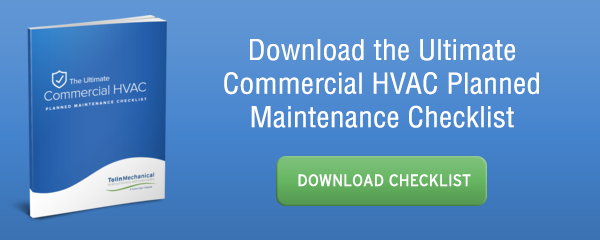The Facility Manager’s Seasonal HVAC Service Checklist
To balance controlling costs and getting the maximum value from your HVAC system, a strategic planned maintenance program is a necessary component of every commercial facility manager’s annual budget.
A custom designed planned maintenance program will:
- Make your equipment last longer
- Dramatically improve energy efficiency
- Limit or eliminate emergency repairs and costly downtime
- Keep tenants comfortable and productive

Unfortunately, an effective maintenance program isn’t quite as simple as having a staff member run through a weekly series of To Do items on a list. A planned maintenance program that’s going to make a difference for your commercial HVAC system involves an entire year’s schedule of inspections, test, and optimization that’s best handled on a scheduled basis by trained and experienced professional technicians.
Sample Commercial HVAC Service Checklist
Here’s a summary of how a strategically designed and scheduled maintenance program will break down throughout the year:
Spring maintenance (May or June)
Before the cooling season really kicks in, all cooling-related components in the system must be inspected, cleaned, and maintained to make sure they’re running at their strongest and most efficient condition. That way, they’ll be in an optimal position to do the best job when you start using your air conditioning more.
Our service area covers a number of different climates, but on average, peak high temperatures happen between July and September, so it’s a good idea to schedule this large-scale inspection and service no later than June.
Summer maintenance (July or August)
A second, less intensive check-up needs to be scheduled for the peak of the cooling season, just to verify that the parts that passed the spring inspection are holding up as expected and that the system is performing as it should under the heavy cooling load.
Where necessary, controls and associated software will be fine-tuned at this point to improve efficiency or usage scheduling.
Autumn maintenance (October or November)
To prepare ahead for the winter heating season, another large-scale inspection and evaluation should be scheduled in the fall before temperatures really start to plummet. Just like the spring inspection, technicians will be evaluate heating system components to make sure they’re ready to handle the energy burden of the heating system.
Since the coldest temperatures in our service area always hit between December and February, this inspection should never wait any later than early November.
Winter maintenance (January or February)
A mirror of the summer maintenance check, the winter inspection is designed to confirm that the heating system is performing properly and operating efficiently during the coldest part of the year.
While all cleaning, repair, and replacement services could potentially be necessary, technicians are more focused on fine tuning controls and boosting efficiency depending on the impact of the winter on system usage patterns.
What’s included in a visual inspection?
All seasonal maintenance visits will include a visual inspection of system components including:
- Heating Sections
- Condensate Drains & Pans
- Bearings
- Flame Composition
- Spray Nozzles & Pans
- Crankcase Heaters
- Igniter & Flame Assembly
- Fan Assemblies
All components will be inspected for signs of wear and needed lubrication, then cleaned to improve function or safety.
What’s included in component testing?
Seasonal planned maintenance visits will also involve using various instruments to test electrical and mechanical components to verify efficiency and performance, and identify areas where improvement can be made.
The following tests should be included:
- Water Flows
- Pressures & Temperatures
- Flow Switch Operations
- Outside Air Intakes
- Control Interlocks
- Refrigerant Pump Down
- Flue Stack Assembly
When combined with careful visual inspection, these tests can identify parts in need of tuning or replacement, and controls that need to be optimized.
There’s a lot to an effective planned maintenance program for your commercial HVAC system. But, when compared to the high cost of replacing neglected equipment or handling an emergency repair, the value becomes plain to see.
If you’d like to discuss what options are available for your facility in Denver, Colorado, Arizona or Virginia, contact our commercial HVAC company today.

